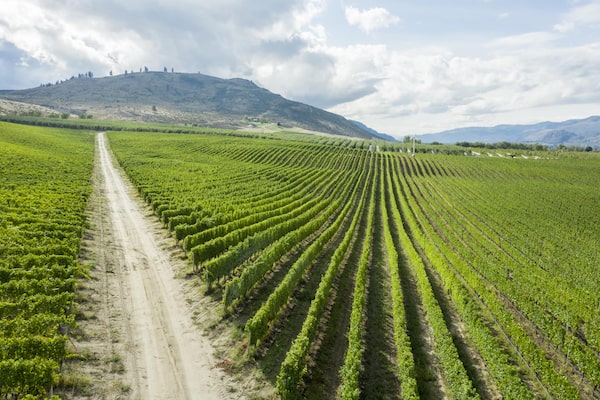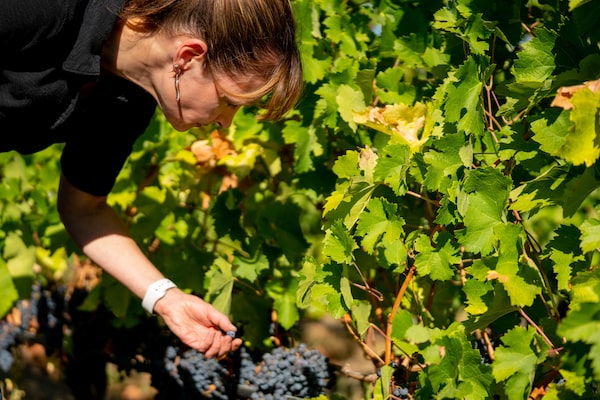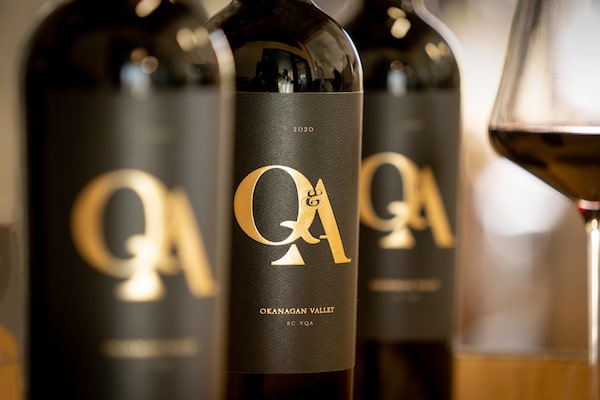
Border Vista Vineyard in Osoyoos, B.C.Supplied
While grape vines slumber during their winter dormancy in the Okanagan Valley, Corrie Krehbiel will sit down next week with the team at Mission Hill Family Estate to start planning for the next vintage of Oculus. Winemakers and viticulturalists (who oversee vineyard growth and development) will taste a range of red wines made last year from different grape varieties and different vineyard blocks to identify what worked and what they hope to change moving forward.
It’s the attention to detail that’s required to produce Mission Hill’s flagship wine, says Krehbiel, who has been Mission Hill’s chief winemaker since 2021. “We really dial it in.”
Mission Hill first produced Oculus from the 1997 vintage. An estimated 500 cases were made from cabernet and merlot grapes purchased from a vineyard on the Black Sage Bench. Winery owner Anthony von Mandl bought that vineyard in 1998, part of his continued investment in British Columbia’s wine country to make bottles to stand alongside the best in the world.
The inaugural Oculus release was priced at $35, a figure that raised eyebrows at a time when the average price of an Okanagan-made wine was $12. The production has grown as Mission Hill has expanded its vineyard holdings across the region. (Although figures aren’t made public, reports suggest Oculus’s annual production is slightly below 2,000 cases). More than 1,200 acres of grapes fuel Mission Hill’s winemaking, which was 100,000 cases in 2018, spread across the reserve, single vineyard and so-called legacy tiers, the latter including Oculus, Quatrain (merlot and syrah based) and Compendium (cabernet sauvignon based).
The 2019 vintage of Oculus, which is available to Mission Hill’s wine club members and is slated for commercial release in spring, carries a $185 price tag. (The average price of an Okanagan grown red is now $21.70 a bottle.)
Since 1998, Oculus has been made exclusively from estate-grown fruit, typically drawing heavily from a vineyard in Osoyoos near the border with Washington State with a small percentage of from the Black Sage Bench site to round out the blend. Vines in what is now known as the Border Vista Vineyard were planted in 1997. Like all of Mission Hill’s vineyards, Border Vista was certified organic in 2020, following the required three years of conversion from using chemical fertilizers, pesticides and other treatments.

Corrie Krehbiel has been Mission Hill’s chief winemaker since 2021.Supplied
There has been marked evolution as the Oculus program has continued. While the vineyards were becoming established, Bordeaux-based consultant Michel Rolland helped refine the winemaking and blending process, after his first visit to the winery in 2004. Based on his recommendations, a winery within the winery was built to produce Oculus and Mission Hill’s other small lot wines. It includes wood fermentators, sorting tables to remove underripe or undesirable grapes and other tools to control production “to get the most out of the grapes,” according to Krehbiel.
Since 2002, the Oculus blend has been built around merlot, with smaller percentages of cabernet franc, cabernet sauvignon and petit verdot, a grape that ripens late in the season so is only used in warm vintages. The aim is to craft an age-worthy wine with rich concentration, serious structure and underlying freshness. With the winery infrastructure settled, Krehbiel says the focus moved to the vineyards. Knowing which sections typically produce the best quality grapes for Oculus and other premium wines allows the winery team to concentrate their efforts to produce the best possible grapes. That’s what next week’s tasting is about, checking on the results of their efforts.
“Oculus is not a recipe,” says Krehbiel. “It is something that we continue to work on and continue to make better every year. In my mind, it’s about having a vision of what Oculus should be and then adapting what the year is giving us to make that vision come true.”
Asked to describe what makes the 2019 version different, Krehbiel points to the elements that stand out: The grapes all came from the same vineyard in Osoyoos. The blend is once again led by merlot, but the percentage of cabernet franc increased over cabernet sauvignon. There’s also the 1 per cent of petit verdot, which increases the floral fragrance and enhance the texture of the wine. “It’s funny to think that 1 per cent can make such a difference,” Krehbiel explains. “But it adds so much width to the finished wine, it’s remarkable.”
Oculus isn’t alone in British Columbia. Other ambitious wineries in the Okanagan and the nearby Similkameen Valley are producing impressive wines based on the Bordeaux cabernet-merlot blend model. Black Hills Nota Bene, Laughing Stock Portfolio and Osoyoos Larose were introduced around the same time as Oculus. More recently, Painted Rock Red Icon, One Faith Grand Vin, Nk’mip Cellars Mer’r’iym, Phantom Creek Cuvée and others make this an exciting category to watch.

Q&A is a label produced by 90210 star and director Jason Priestley, broadcaster Terry David Mulligan and Winemaker’s Cut founder Michal Mosny.Supplied
A new addition promises to attract even more attention. Q&A is a label produced by 90210 star and director Jason Priestley, broadcaster Terry David Mulligan and Winemaker’s Cut founder Michal Mosny, who was inspired to move to the Okanagan to start a winery based on an episode of Hollywood & Vines, a wine-related travel show hosted by Priestley and Mulligan.
Priestley was previously part of an Alberta-based group that owned Black Hills Estate Winery until its sale to Andrew Peller Limited in 2017. “After the sale, I continued to search for exceptional terroir capable of producing a peerless Bordeaux-style blend,” Priestley said in a statement. “After looking everywhere, all roads lead to one answer and the answer is once again in the Okanagan.”
The trio launched Q&A 2020 in November. It sells for $50 a bottle online via winemakerscut.ca
Oculus and similarly priced wines are out of reach for most wine lovers – some might see that average $21.70 price for an Okanagan red as splurge – but there isn’t a question of whether there’s an audience for these wines. Oculus 2019 is the 22nd vintage of a wine that will continue with the release of the hotly anticipated 2020 edition next year. Collectors, sommeliers and others embrace it year after year.
The true value of these wines isn’t necessarily in the bottle being purchased, however. It’s in how that investment of time, energy and resources improve the next vintage of British Columbia’s wine across the board. Lessons learned in the Okanagan refining Oculus, Nota Bene and Red Icon don’t just benefit those labels, they help the industry as a whole by raising the profile and overall quality. You can bet that Mission Hill’s more affordable, larger volume Reserve Meritage is better than ever because of the research and development that go into handcrafting Oculus to be a shining example of the Okanagan’s best.
Plan your weekend with our Good Taste newsletter, offering wine advice and reviews, recipes, restaurant news and more. Sign up today.